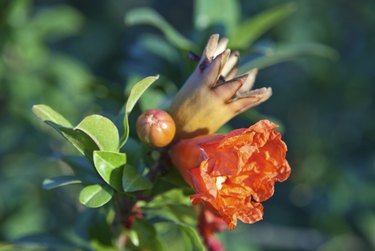
Producing colorful orange-red blossoms and edible fruit, pomegranate trees (Punica granatum) grow in the warm climates of U.S. Department of Agriculture plant hardiness zones 8 through 11. Pomegranate trees attract various insects that can damage the leaves and reduce your fruit crop. Although commercial pesticides effectively get rid of these insects, the chemicals in them often do more harm than good. Several natural, less toxic options are available so you can kill insects without the fear of dangerous chemicals on your pomegranate fruits.
Pomegranate Insects
Video of the Day
Aphids can become serious pests on pomegranate trees, with cotton aphids generally causing the most damage with severe infestations. Other insect pests that attack pomegranates include leaffooted bugs, mealybugs, soft scales, thrips and whiteflies. The larvae of various moths and butterflies also feed on pomegranate leaves, including omnivorous leafrollers, navel orangeworms, filbertworms and carob moths.
Video of the Day
Insecticidal Soap
Containing fatty acids that break down quickly in the environment, insecticidal soaps effectively control small, soft-bodied plant pests, including aphids, whiteflies, mealybugs and leaffooted bug nymphs. These soaps work by stripping off the insect's protective outer covering, causing dehydration and death. Although fatal to insects, insecticidal soaps don't affect people, pets, birds or most beneficial insects.
Mix a soap concentrate according to the instructions on the product's label. Most products recommend using a 1 to 2 percent solution, which means mixing 2 1/2 to 5 tablespoons of concentrate for every 1 gallon of water. Pour the mixture into a garden sprayer. The solution must make direct contact with the pests to be effective, so thoroughly coat leaf surfaces, including the undersides where many common pomegranate pests congregate. Repeat applications every four to seven days until the pests disappear. Avoid spraying soap solutions when temperatures are above 90 degrees Fahrenheit or you risk damaging the pomegranate tree's leaves.
Neem Oil
Neem oils kill various pomegranate pests, including soft scale crawlers, mites, whiteflies, leaffooted nymphs and aphids. The oil works by blocking air holes and resulting in death by suffocation. Extracted from a tropical tree, this natural insecticide has few risks for, pets or other animals that prey on pest insects.
Follow the directions on the product's label. One product recommends mixing 2 to 4 tablespoons of neem oil concentrate with 1 gallon of water. Pour the solution into a garden sprayer and spray all leaf surfaces, including beneath the leaves, until the foliage glistens with moisture. You must completely cover the plant tissue for the solution to work effectively. Repeat applications every seven to 14 days until pests disappear. Avoid spraying when temperatures dip below freezing or soar over 100 F or you risk damaging the temperature-stressed foliage.
Bacterium Insecticide
Products containing the bacterium Bacillus thuringiensis subspecies kurstaki help control various caterpillars, including the omnivorous leafroller, navel orangeworm, filbertworm and carob moth that feed on pomegranates. Once the caterpillar eats the bacterium, it interrupts its digestive process and causes the pest to stop feeding within a few hours and die within a few days. Although fatal to larval pests, Btk isn't toxic to people, pets, fish, birds, earthworms, lady beetles or honeybees. The bacterium can affect butterfly larvae, so don't use Btk on a pomegranate tree near a butterfly garden.
Read the directions on the product's label before use. One product suggests mixing 3 to 4 teaspoons of Btk concentrate with every 1 gallon of water. Use a small garden sprayer to thoroughly cover the tops and undersides of foliage because pests must eat the solution for it to work. Start treating when you first notice the caterpillars and repeat applications every five to seven days while the larvae remain active.
A Few Considerations
Although natural insect sprays aren't generally toxic to people and pets, they can still irritate skin and eyes on contact. Reduce your risk of irritation by wearing waterproof gloves, goggles, long sleeves, long pants, socks with shoes and a face mask when mixing and spraying pesticides. Don't spray on windy days and don't spray into the wind. Keep family members and pets away from the treated area until the solution dries, which generally takes at least four hours.
Spray plants only in calm weather and when no rain is expected for the following 24 hours. Spraying in the early morning or around dusk allows the solution to remain active longer because it won't evaporate as quickly. Neem oil is toxic to bees if it makes direct contact with the insects, so spraying early or late in the day or on a cloudy day also minimizes the risk of harming the pollinators.
- UC Statewide IPM Online: Less Toxic Insecticides
- Floridata: Punica Granatum
- UC Statewide IPM Online: Scales
- University of California: Pomegranate Pest Management in the San Joaquin Valley
- Colorado State University Extension: Insect Control: Horticultural Oils
- UC Statewide IPM Online: Pomegranate -- Punica Granatum
- Clemson Cooperative Extension: Insecticidal Soaps for Garden Pest Control
- UC Statewide IPM Online: Leaffooted Bug
- UC Statewide IPM Online: Filbertworm
- UC Statewide IPM Online: Navel Orangeworm and Carob Moth
- Missouri Botanical Garden: Azadirachta Indica
- Missouri Botanical Garden: Bacillus Thuringiensis (Bt) Kurstaki and Israelensis Strains